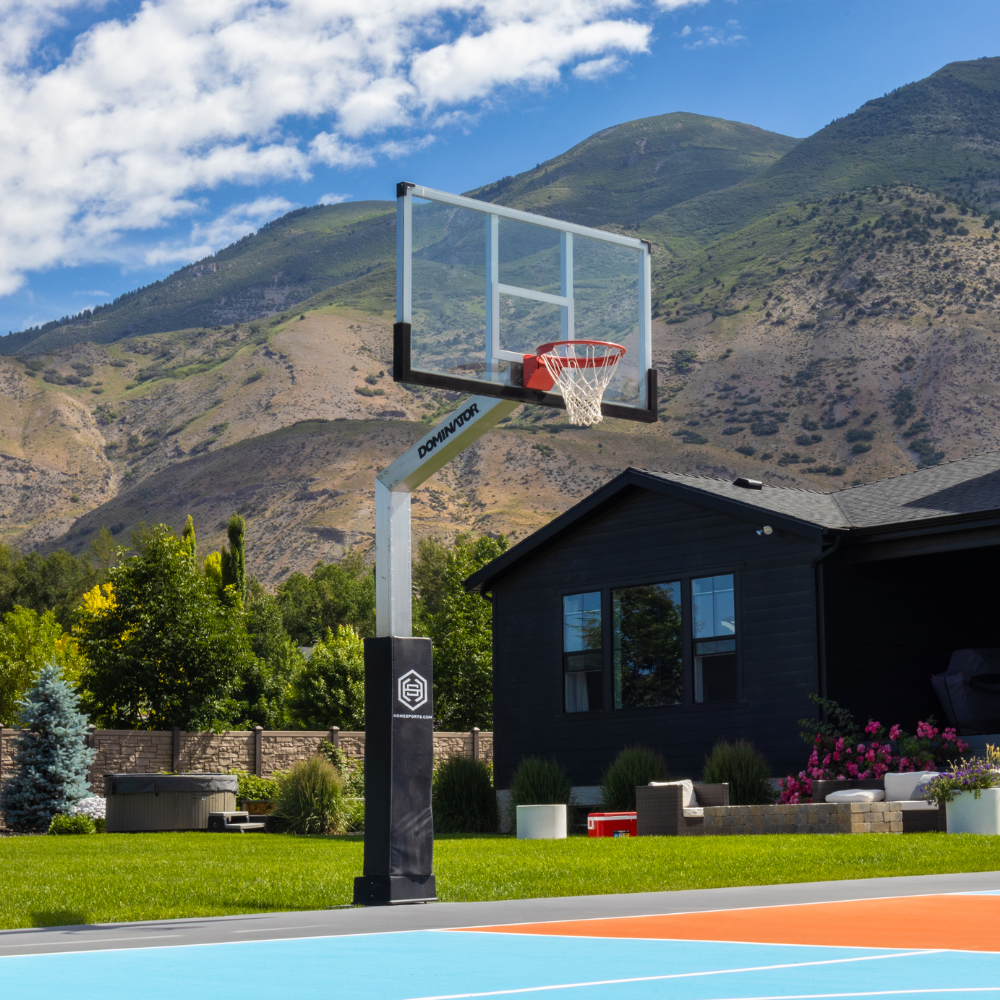Basketball
Height, Materials, and More: How to Choose a Basketball Hoop
If you’ve ever set foot on a basketball court or watched a game, you’ve probably noticed that the hoop is always at a consistent height. But have you ever wondered exactly how tall a basketball hoop is and why that height was chosen? Whether you’re a player, a coach, or just a curious fan, understanding the standard height of a basketball hoop is essential. You also need to learn about location, materials, and the backboard.
Hoop Location
Your hoop’s location determines whether you’ll have a thrilling match or struggle to line up every shot. Some of the most important details when learning how to choose a basketball hoop are the unique details of physical locations like driveways, backyard courts, and pools.
Driveway
When you don’t have a dedicated basketball court, a driveway usually provides enough space to get some practice in. It’s a good pick for casual players as well as more experienced players on a budget.
Spacious driveways provide a mixture of open space and asphalt to replicate the feel of a basketball court. However, make sure your driveway isn’t too narrow: you should have a minimum of 15 feet in front of your basketball hoop so you can practice your free throws. Keep in mind that basketball hoops can’t hang over a street or sidewalk for safety purposes.
The main downside to setting up a basketball hoop near the driveway is potential traffic, such as cars pulling in or out. You’ll need to establish a practice schedule so you can keep your head in the game without worrying about traffic interruptions.
Our premier Dominator 60 works great in a driveway and is our solution for casual and experienced players who need a quality hoop for a smaller space.
Backyard Court
If you have room for it, a backyard court gives you a personalized space to polish your skills. This approach is popular for homeowners with extra space as well as experienced players considering a professional career.
Learning how to choose a basketball hoop means considering what your average game will look like. With all the extra space, backyard courts can accommodate more players or big families who want to spend time together. Since friends or friendly members might get involved, a larger hoop that can withstand more activity is essential.
The Dominator 72 is our flagship adjustable basketball hoop, and it’s full-size for players who want active matches with multiple people.
Pool
Basketball and swimming may be a match made in heaven, but you still need a specialized basketball hoop designed for this unique environment. Since pool-focused basketball hoops are exposed to more water, they need waterproof materials to avoid rusting or discoloration.
Our Dominator Aluminum Poolside Inground Basketball Hoop has a waterproof vinyl-coated rim and acrylic backboard to hold up to splashing or spraying. Its flexible aluminum design not only keeps rust at bay, it flexes under impact and brings the thrill of the court right to your home pool.
Which Basketball Hoop is Best in a Driveway?
Driveway basketball hoops need to be small enough to fit in a driveway space yet sturdy enough to hold up to heavy use. Our Dominator 60 offers a smaller overhang and modified backboard to easily fit comfortably in your driveway.

Backboard Sizing
Figuring out how to choose a basketball hoop requires considering the best backboard for your performance and personal goals. Larger backboards more closely replicate the feel of a professional court, while smaller backboards are ideal for casual players and families.
The most common sizes for backboards (in terms of width) are:
- 48”
- 54”
- 60”
- 70”
- 72”
72” x 42” is the regulation size for official games, making it a solid pick for aspiring professionals or college athletes. We offer the Dominator Pro 72 with a shatterproof backboard that can hold up against intense, high-impact games.
Backboard Material
Your basketball hoop’s backboard needs to hold up to missed throws and the elements. While all materials have their pros and cons, some are more versatile.
Polycarbonate
This clear plastic is common in basketball backboards for its affordability and simple design. While it holds up well to impact, it tends to yellow from UV exposure after a few years.
As such, polycarbonate basketball hoops are far better suited to indoor basketball hoops than outdoors.
Acrylic
When you want an equally tough material to polycarbonate that holds up better to sunlight, acrylic offers the best of both worlds. Acrylic holds up well to repeated impact without cracking, chipping, or denting.
Many people enjoy acrylic because it doesn’t turn yellow from the sun, appearing brand new for two decades or more. When learning how to choose a basketball hoop, it’s worth considering how your investment will look alongside your outdoor fixtures long-term.
Aluminum
Basketball hoops are pretty heavy, so aluminum provides a lightweight option that doesn’t skimp on durability. Aluminum is rust-resistant, so it won’t become blotchy or chip from mist and rain.
When combined with a stable, inground design, aluminum backboards offer an enjoyable experience that lasts for decades.
We offer an aluminum backboard for our Dominator Pro 72, giving you a powerful combination of tensile strength, longevity, and rust resistance.
Tempered Glass
The tempered glass backboard is a classic staple of school and university basketball courts. Manufacturers design this glass up to ten times stronger than regular glass to hold up to repeated rebounds.
While tough, tempered glass is still less durable than acrylic and heavier than aluminum.

The Standard Height: 10 Feet
Learning how to choose a basketball hoop means understanding the importance of standardized heights and how they relate to a person’s growth as a player. The official height of a basketball hoop in professional leagues, including the NBA, WNBA, and international competitions, is 10 feet (3.05 meters) from the floor to the rim.
This height has remained unchanged since the game’s invention by Dr. James Naismith in 1891. The consistency of this height across all levels of play, from youth leagues to the pros, is one of the key factors that maintain the integrity and challenge of the game.
The 10-foot height was initially chosen somewhat arbitrarily. When Dr. Naismith first hung a peach basket (the original hoop) in the Springfield, Massachusetts, gym, the railing he used happened to be 10 feet high. This height proved to be challenging, yet achievable, making the game exciting and competitive.
Over time, the 10-foot height became standardized as the sport grew in popularity.
How Do I Choose a Basketball Hoop for My Child?
When choosing which basketball hoop to buy for your children, take into account their skill as well as eventual growth spurts. While the standard height is 10 feet, it’s important to note that different age groups may use lower hoops to accommodate varying skill levels and physical capabilities.
- Ages 5-7: 6 feet (1.83 meters)
- Ages 8-10: 8 feet (2.44 meters)
- Ages 11-12: 9 feet (2.74 meters)
- Ages 13 and older: 10 feet (3.05 meters)
Lowering the hoop allows younger players to develop proper shooting form and enjoy the game without the frustration of a hoop that feels too high.

Adjustable Basketball Hoops
Many modern basketball systems, particularly those designed for home use, offer the convenience of adjustable heights. Dominator’s hoops, for example, allow you to lower the rim to as low as 7.5 feet, making it perfect for younger children who are just starting to practice and build confidence.
As they grow and their skills advance, the hoop can easily be raised to the standard 10 feet, ensuring the court adapts to their development every step of the way. Our Dominator 54 adjustable basketball hoop grows with you, providing a flexible design and a smaller backboard for limited spaces.
The Importance of Consistency
Maintaining a consistent hoop height is crucial for the development of players at all levels. A 10-foot hoop ensures that players can transition smoothly from one level of play to the next, whether they’re moving from youth leagues to high school basketball, college, or professional play.
It also ensures that the fundamental skills learned at an early age, such as shooting and dunking, remain relevant throughout a player’s career.
Transform Your Game With a Customized Hoop
When you know how to choose a basketball hoop, you pave the way for exciting and challenging games for years to come. While the standard height is 10 feet, the right height ultimately depends on the needs of the players and the space available.
Customizing the hoop’s height allows players to feel more comfortable and confident, helping them to perform at their best. For those looking to create the perfect playing environment, Dominator offers a selection of top-notch basketball hoops that can be adjusted to suit any space.
Whether for a backyard game or a serious setup, Dominator hoops provide flexibility and quality. Explore our range of hoops today to elevate your game!




















